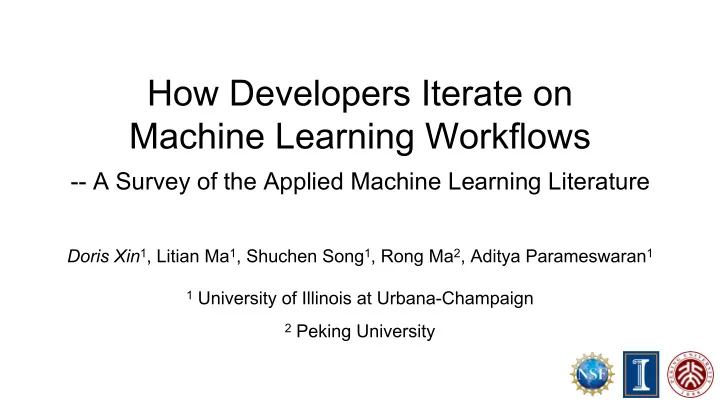

How Developers Iterate on Machine Learning Workflows -- A Survey of the Applied Machine Learning Literature Doris Xin 1 , Litian Ma 1 , Shuchen Song 1 , Rong Ma 2 , Aditya Parameswaran 1 1 University of Illinois at Urbana-Champaign 2 Peking University
Developing Machine Learning Applications is Iterative Images, text, logs, Input data tables, etc. Data cleaning, Data Preprocessing Add features, feature eng., etc. scale features, etc. Train ML models, Add regularization, Make predictions w/ Learning/Inference change model type, etc. trained models Change metrics, Evaluation, drill down on results, etc. Interpretation & Post Processing Explanation 2
Interactive ! Developing Machine Learning Applications is Iterative Input data Creating systems to Data Preprocessing ( DPR ) Data Preprocessing ( DPR ) enhance interactivity requires a statistical characterization of how developers iterate Learning/Inference ( L/I ) Learning/Inference ( L/I ) on ML workflows . Post Processing ( PPR ) Post Processing ( PPR ) Num. Iterations 3
How Do Developers Iterate on Machine Learning Workflows? Try new neural Data cleaning! net architecture Better features! BLEU vs. ROUGE Computer Vision Web App Natural Sciences NLP 4
How Do Developers Iterate on Machine Learning Workflows? Our approach : study iterations by collecting statistics from applied ML papers grouped by application domains . 5
Outline ● Data & Limitations ● Methodology ○ Statistics ○ Estimation ● Results ● Conclusion & Future Work 6
Outline ● Data & Limitations ● Methodology ○ Statistics ○ Estimation ● Results ● Conclusion & Future Work 7
Corpus: 105 Papers from 2016 Limitations ● Incomplete picture of iterations ○ Focus on ML and omit DPR ● Results presented side-by-side ○ Can’t determine the order ● # papers / domain is small ○ May lead to spurious results Remedies ● Multiple surveyors to reduce chance of spurious results ● Iteration estimators that do not rely on order 8
Outline ● Data & Limitations ● Methodology ○ Statistics ○ Estimation ● Results ● Conclusion & Future Work 9
Collecting Statistics Data Prep. ML Model Class ML Tuning Evaluation Metrics norm. impute ... LSTM SVM ... Reg. Learn. Rate ... AUC ... # tables # figs 5 2 5 2 5 2 Aggregate 5 2 10 Open source dataset at https://github.com/helix-ml/AppliedMLSurvey
Estimating Iterations Data Prep. ML Model Class ML Tuning Evaluation Metrics norm. impute ... LSTM SVM ... Reg. Learn. Rate ... AUC ... # tables # figs Aggregate 5 2 Number of data prep. iterations Number of ML iterations Number of post proc. iterations 11
Outline ● Data & Limitations ● Methodology ○ Statistics ○ Estimation ● Results ● Conclusion & Future Work 12
Mean Iteration Count by Domains 13
Data Preprocessing Social Sciences Natural Sciences Web Apps NLP Computer Vision Join (31.0%) Feat. Def . (40.6%) Feat. Def. (36.1%) Feat. Def. (32.1%) Feat. Def. (37.5%) Feat. Def. (27.6%) Univar. FS (18.8%) Join (22.2%) BOW (17.9%) BOW (25.0%) Normalize (17.2%) Normalize (12.5%) Normalize (13.9%) Join (14.3%) Interaction (25.0%) Impute (6.9%) PCA (9.4%) Discretize (8.3%) Normalize (10.7%) Join (12.5%) Feat. Def. = human defined features from raw attributes ● ○ e.g. adult=true if age >=18 14
ML Model Classes Social Sciences Natural Sciences Web Apps NLP Computer Vision GLM (36.0%) SVM (32.7%) GLM (37.0%) RNN (32.4%) CNN (38.2%) SVM (28.0%) GLM (15.4%) SVM (11.1%) GLM (14.7%) SVM (17.6%) RF (20.0%) RF (13.5%) RF (11.1%) SVM (11.8%) RNN (17.6%) DNN(13.5%) CNN (8.8%) RF (5.9%) Decision Tree (12.0%) Matrix Factor. (11.1%) ● Generalized linear models: logistic regression, linear regressions, etc. ● SVMs are popular (especially in natural sciences!) possibly due to kernels ● Deep learning is only popular in NLP and computer vision so far 15
ML Model Tuning Social Sciences Natural Sciences Web Apps NLP Computer Vision Regularize (40.0%) Cross Val. (31.8%) Regularize (41.2%) Learn Rate (39.4%) Learn Rate (46.2%) Cross Val. (30.0%) Learn Rate (22.7%) Learn Rate (23.5%) Batch Size (24.2%) Batch Size (30.8%) Learn Rate (10.0%) DNN Arch. (18.2%) Batch Size (11.8%) DNN Arch. (18.2%) DNN Arch. (11.5%) Batch Size (10.0%) Kernel (9.1%) Cross Val. (11.8%) Kernel (6.1%) Regularize (11.5%) ● Learning Rate + Batch Size → looking for faster training 16
Post Processing Social Sciences Natural Sciences Web Apps NLP Computer Vision Prec/Rec (25.7%) Accuracy (28.6%) Accuracy (20.8%) Prec/Rec (29.2%) Visualiz. (33.3%) Accuracy (20.0%) Prec/Rec (18.6%) Prec/Rec (20.8%) Accuracy (27.1%) Accuracy (29.8%) Visualiz. (15.7%) Prec/Rec (17.5%) Feat. Contrib. (17.1%) Case Studies (13.2%) Case Studies (14.6%) Visualiz. (14.3%) Correlation (11.4%) DCG (9.4%) Human Eval (8.3%) Case Studies (12.3%) ● Precision/Recall & Accuracy → coarse-grained evaluation ● Case Studies & Visualization → fine-grained evaluation 17
Takeaways Study iteration using empirical evidence from applied ML papers ● ○ Grouping by domains gives better insights Lessons from results ● ○ Data prep : fine-grained feature engineering, efficient joins ○ ML : explainable models and fast training ○ Eval : fine-grained evals are as common as coarse-grained metrics ● Open source dataset at https://github.com/helix-ml/AppliedMLSurvey 18
Future Work Refine statistics and estimators ● Develop insights and trends into a benchmark ● Look at code repositories (e.g. Kaggle) for a more complete picture ● DAG Optimizer q Address user needs discovered in our survey Accelerate Iterative Execution Materialization Intermediate q Selectively materialize Optimizer Code Gen. via Intermediates Reuse intermediate results for reuse in future iterations https://helix-ml.github.io 19 More on Helix in the technical report @ http://data-people.cs.illinois.edu/helix-tr.pdf
20
Recommend
More recommend